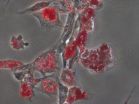(Press-News.org) SAN FRANCISCO, Aug. 11, 2014 — For the millions of adults and children in the U.S. who have to shun nuts to avoid an allergic reaction, help could be on the way. Scientists are now developing a method to process cashews — and potentially other nuts — that could make them safer to eat for people who are allergic to them.
The researchers are presenting their work at the 248th National Meeting & Exposition of the American Chemical Society (ACS), the world's largest scientific society. The meeting, being held here through Thursday, features nearly 12,000 presentations on a wide range of science topics.
"The only widely accepted practice for preventing an allergic reaction to nuts is strict avoidance — stay away from the food," notes Chris Mattison, Ph.D. "Clinical trials to test immunotherapy are underway, but we're approaching it from an agricultural perspective rather than medical. Can we change the food, instead of treating the person, so we can eliminate or reduce severe reactions?"
For those with food allergies, responses to offending products can range from mild itching in the mouth or skin to life-threatening anaphylaxis, which makes it hard to breathe. Once every three minutes, someone in the U.S. ends up in the emergency room due to a food allergy reaction — that adds up to about 200,000 visits a year.
To try to reduce those numbers, Mattison's team is looking at ways to modify proteins in tree nuts and peanuts (which are legumes) that trigger an immune response in people who are allergic. The response is launched by antibodies called immunoglobulin E (IgE), which recognize and latch onto the proteins. Mattison explains that changing the shape of the proteins makes it harder for IgE to find them.
But past research taking this approach has involved harsh chemicals. Mattison, a researcher with the Agricultural Research Service branch of the U.S. Department of Agriculture, wanted to see if his team could achieve the same results, but using compounds that are "generally regarded as safe," or GRAS. These are substances that are accepted by the Food and Drug Administration for use in food and pharmaceuticals.
"We found that the GRAS compound sodium sulfite can effectively disrupt the structure of a couple of the cashew allergens," Mattison says. "And we've done a couple of different tests to show we reduced IgE binding to the proteins when they've been treated with sodium sulfite."
Next, they plan to conduct experiments on whole nuts and test the modified proteins on cells in the lab to see how they respond. They're also looking at enzymes, which are molecules that can cut up proteins, as candidates to disrupt the allergens.
And, although this particular report focuses on cashew proteins, Mattison says the work could have broader implications. The kinds of allergenic proteins the GRAS compound and enzymes affect are not exclusive to one kind of nut.
"One of our goals is to apply our knowledge from the cashew experiments to other tree nuts and to peanuts," he says.
INFORMATION:
Mattison acknowledges funding from the U.S. Department of Agriculture-Agricultural Research Service.
The American Chemical Society is a nonprofit organization chartered by the U.S. Congress. With more than 161,000 members, ACS is the world's largest scientific society and a global leader in providing access to chemistry-related research through its multiple databases, peer-reviewed journals and scientific conferences. Its main offices are in Washington, D.C., and Columbus, Ohio.
To automatically receive news releases from the American Chemical Society, contact newsroom@acs.org.
Note to journalists: Please report that this research is being presented at a meeting of the American Chemical Society.
Follow us: Twitter | Facebook
Title
Processing routes to reduce IgE binding to cashew allergens
Abstract
Tree nuts are an important part of a healthy diet, but they can be a serious threat to those with tree nut allergy. Three seed storage proteins, Ana o 1, 2, and 3, have been identified as major cashew nut allergens that are bound by IgE in cashew allergic patients. Reactions to cashew nuts are often severe and methods aimed at reducing or eliminating the ability of cashew and other tree nuts to cause allergy would be beneficial to those who suffer from nut allergy. Proteolytic treatment of cashew allergens in vitro indicates that methods incorporating enzymatic breakdown of cashew allergens could be used to reduce IgE binding. Similarly, chemical treatment of cashew extracts with generally regarded as safe (GRAS) compounds such as sodium sulfite can disrupt cashew allergen structure and reduce IgE binding. Continued research is needed to develop improved methods for the attenuation of cashew and other tree nut allergens in order to lessen the likelihood of severe food allergy reactions.
Making cashews safer for those with allergies
2014-08-11
ELSE PRESS RELEASES FROM THIS DATE:
Venom gets good buzz as potential cancer-fighter (video)
2014-08-11
SAN FRANCISCO, Aug.11, 2014 — Bee, snake or scorpion venom could form the basis of a new generation of cancer-fighting drugs, scientists will report here today. They have devised a method for targeting venom proteins specifically to malignant cells while sparing healthy ones, which reduces or eliminates side effects that the toxins would otherwise cause.
The report was part of the 248th National Meeting of the American Chemical Society (ACS), the world's largest scientific society. The meeting, attended by thousands of scientists, features nearly 12,000 reports on new ...
US lung cancer rates vary by subtype, sex, race/ethnicity, and age
2014-08-11
A new analysis confirms that US lung cancer rates are declining overall, but it also uncovers previously unrecognized trends related to cancer subtype, sex, race/ethnicity, and age. Published early online in CANCER, a peer-reviewed journal of the American Cancer Society, the findings provide a more accurate picture of the state of lung cancer in the country and will help researchers in their ongoing efforts to monitor the population's lung health.
Overall, lung cancer rates are declining in the United States, but little is known about trends related to different subtypes ...
One in 6 lupus patients readmitted to hospital within 30 days of discharge
2014-08-11
A new study reveals that one in six patients with systemic lupus erythematosus (SLE) is readmitted to the hospital within 30 days of being discharged. Results published in Arthritis & Rheumatology, a journal of the American College of Rheumatology (ACR), show that black and Hispanic SLE patients were more likely to be readmitted than white patients. Readmissions among patients insured by Medicare or Medicaid were also more likely compared to patients covered by private insurance.
Lupus is a systemic, autoimmune disease where an overactive immune system attacks healthy ...
Postmenopausal breast cancer risk decreases rapidly after starting reg. physical activity
2014-08-11
PHILADELPHIA — Postmenopausal women who in the past four years had undertaken regular physical activity equivalent to at least four hours of walking per week had a lower risk for invasive breast cancer compared with women who exercised less during those four years, according to data published in Cancer Epidemiology, Biomarkers & Prevention, a journal of the American Association for Cancer Research.
"Twelve MET-h [metabolic equivalent task-hours] per week corresponds to walking four hours per week or cycling or engaging in other sports two hours per week and it is consistent ...
Breech babies have higher risk of death from vaginal delivery compared to C-section
2014-08-11
While a rise in cesarean section (C-section) delivery rates due to breech presentation has improved neonatal outcome, 40% of term breech deliveries in the Netherlands are planned vaginal deliveries. According to a new Dutch study that is published today in Acta Obstetricia et Gynecologica Scandinavica, a journal of the Nordic Federation of Societies of Obstetrics and Gynecology, there is a 10-fold increase in fetal mortality in vaginal delivery for breech presentation compared to elective C-section.
Up to 4% of deliveries are breech births—when the baby is delivered buttocks ...
Spectacular 3-D sketching system revolutionizes design interaction and collaboration
2014-08-11
Collaborative three-dimensional sketching is now possible thanks to a system known as Hyve-3D that University of Montreal researchers are presenting today at the SIGGRAPH 2014 conference in Vancouver. "Hyve-3D is a new interface for 3D content creation via embodied and collaborative 3D sketching," explained lead researcher Professor Tomás Dorta, of the university's School of Design. "The system is a full scale immersive 3D environment. Users create drawings on hand-held tables. They can then use the tablets to manipulate the sketches to create a 3D design within the space". ...
Discovery of new form of dystrophin protein could lead to therapy for some DMD patients
2014-08-10
Scientists have discovered a new form of dystrophin, a protein critical to normal muscle function, and identified the genetic mechanism responsible for its production. Studies of the new protein isoform, published online Aug. 10 in Nature Medicine and led by a team in The Research Institute at Nationwide Children's Hospital, suggest it may offer a novel therapeutic approach for some patients with Duchenne muscular dystrophy, a debilitating neuromuscular condition that usually leaves patients unable to walk on their own by age 12.
Duchenne muscular dystrophy, or DMD, ...
Scientists unlock key to blood vessel formation
2014-08-10
Scientists from the University of Leeds have discovered a gene that plays a vital role in blood vessel formation, research which adds to our knowledge of how early life develops.
The discovery could also lead to greater understanding of how to treat cardiovascular diseases and cancer.
Professor David Beech, of the School of Medicine at the University of Leeds, who led the research, said: "Blood vessel networks are not already pre-constructed but emerge rather like a river system. Vessels do not develop until the blood is already flowing and they are created in response ...
Newly discovered heart molecule could lead to effective treatment for heart failure
2014-08-10
INDIANAPOLIS -- Researchers have discovered a previously unknown cardiac molecule that could provide a key to treating, and preventing, heart failure.
The newly discovered molecule provides the heart with a tool to block a protein that orchestrates genetic disruptions when the heart is subjected to stress, such as high blood pressure.
When the research team, led by Ching-Pin Chang, M.D., Ph.D., associate professor of medicine at the Indiana University School of Medicine, restored levels of the newly discovered molecule in mice experiencing heart failure, the progression ...
Bioengineers: Matrix stiffness is an essential tool in stem cell differentiation
2014-08-10
Bioengineers at the University of California, San Diego have proven that when it comes to guiding stem cells into a specific cell type, the stiffness of the extracellular matrix used to culture them really does matter. When placed in a dish of a very stiff material, or hydrogel, most stem cells become bone-like cells. By comparison, soft materials tend to steer stem cells into soft tissues such as neurons and fat cells. The research team, led by bioengineering professor Adam Engler, also found that a protein binding the stem cell to the hydrogel is not a factor in the differentiation ...




